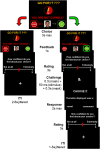How the Brain Converts Negative Evaluation into Performance Facilitation
- PMID: 28057723
- PMCID: PMC6676962
- DOI: 10.1093/cercor/bhw400
How the Brain Converts Negative Evaluation into Performance Facilitation
Abstract
Surpassing negative evaluation is a recurrent theme of success stories. Yet, there is little evidence supporting the counterintuitive idea that negative evaluation might not only motivate people, but also enhance performance. To address this question, we designed a task that required participants to decide whether taking up a risky challenge after receiving positive or negative evaluations from independent judges. Participants believed that these evaluations were based on their prior performance on a related task. Results showed that negative evaluation caused a facilitation in performance. Concurrent functional magnetic resonance imaging revealed that the motivating effect of negative evaluation was represented in the insula and striatum, while the performance boost was associated with functional positive connectivity between the insula and a set of brain regions involved in goal-directed behavior and the orienting of attention. These findings provide new insight into the neural representation of negative evaluation-induced facilitation.
Keywords: decision-making; neuroimaging; performance; psychological reactance.
© The Author 2017. Published by Oxford University Press. All rights reserved. For Permissions, please e-mail: journals.permissions@oup.com.
Figures




Similar articles
-
Why we stay with our social partners: Neural mechanisms of stay/leave decision-making.Soc Neurosci. 2018 Dec;13(6):667-679. doi: 10.1080/17470919.2017.1370010. Epub 2017 Sep 3. Soc Neurosci. 2018. PMID: 28820016
-
Adolescent Decision-Making Under Risk: Neural Correlates and Sex Differences.Cereb Cortex. 2020 Apr 14;30(4):2690-2706. doi: 10.1093/cercor/bhz269. Cereb Cortex. 2020. PMID: 31828300 Free PMC article.
-
A neural network that links brain function, white-matter structure and risky behavior.Neuroimage. 2017 Apr 1;149:15-22. doi: 10.1016/j.neuroimage.2017.01.058. Epub 2017 Jan 25. Neuroimage. 2017. PMID: 28131889 Free PMC article.
-
[Risk-taking in adolescence: A neuroeconomics approach].Encephale. 2010 Apr;36(2):147-54. doi: 10.1016/j.encep.2009.06.004. Epub 2009 Sep 22. Encephale. 2010. PMID: 20434632 Review. French.
-
Multiple Systems for the Motivational Control of Behavior and Associated Neural Substrates in Humans.Curr Top Behav Neurosci. 2016;27:291-312. doi: 10.1007/7854_2015_386. Curr Top Behav Neurosci. 2016. PMID: 26370947 Review.
Cited by
-
Neural substrates of social facilitation effects on incentive-based performance.Soc Cogn Affect Neurosci. 2018 Apr 1;13(4):391-403. doi: 10.1093/scan/nsy024. Soc Cogn Affect Neurosci. 2018. PMID: 29648653 Free PMC article.
References
-
- Antonucci AS, Gansler DA, Tan S, Bhadelia R, Patz S, Fulwiler C. 2006. Orbitofrontal correlates of aggression and impulsivity in psychiatric patients. Psychiatry Res. 147:213–220. - PubMed
-
- Brehm JW. 1966. A theory of psychological reactance In: Burke WW, Lake DG, Paine JV, editors. Organization change: a comprehensive reader. Wiley, San Francisco: Jossey-Bass.
-
- Brockner J, Elkind M. 1985. Self-esteem and reactance: further evidence of attitudinal and motivational consequences. J Exp Soc Psychol. 21:346–361.
Publication types
MeSH terms
Grants and funding
LinkOut - more resources
Full Text Sources
Other Literature Sources

